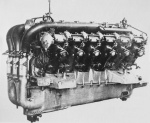Click to view all Aircraft Engines: Through World War I articles starting with the most recent.
 Antoinette (Levavasseur) Aircraft Engines - Léon Levavasseur’s V-8 and V-16 Antoinette aircraft engines powered the aircraft used by many early pioneer aviators in Europe.
Antoinette (Levavasseur) Aircraft Engines - Léon Levavasseur’s V-8 and V-16 Antoinette aircraft engines powered the aircraft used by many early pioneer aviators in Europe. Anzani 20-Cylinder Aircraft Engine - The Anzani 20-cylinder radial was one of the largest and most-powerful aircraft engines when it was first run in 1913. However, sales of the engine were few, and World War I put an end to production.
Anzani 20-Cylinder Aircraft Engine - The Anzani 20-cylinder radial was one of the largest and most-powerful aircraft engines when it was first run in 1913. However, sales of the engine were few, and World War I put an end to production. Breton Rotary Aircraft Engine - The Breton Rotary was a 12-cylinder aircraft engine designed to be compact and light. Built in 1909, the 60 hp (45 kW) engine was exhibited at the Salon de l'aéronautique in France but did not enter production.
Breton Rotary Aircraft Engine - The Breton Rotary was a 12-cylinder aircraft engine designed to be compact and light. Built in 1909, the 60 hp (45 kW) engine was exhibited at the Salon de l'aéronautique in France but did not enter production. Daimler-Mercedes D VI W-18 Aircraft Engine - The Daimler-Mercedes D VI was a powerful W-18 engine developed to power large R-planes during WWI. Other projects took priority over the D VI, and the German engine never went into production.
Daimler-Mercedes D VI W-18 Aircraft Engine - The Daimler-Mercedes D VI was a powerful W-18 engine developed to power large R-planes during WWI. Other projects took priority over the D VI, and the German engine never went into production. Deissner ‘Paradox’ Rotary Aircraft Engine - Designed by Charles Deissner of England, the Paradox rotary engine was an attempt to provide an improved power plant for early aviators.
Deissner ‘Paradox’ Rotary Aircraft Engine - Designed by Charles Deissner of England, the Paradox rotary engine was an attempt to provide an improved power plant for early aviators. Duesenberg Aircraft Engines: A Technical Description - Authored by William Pearce, Duesenberg Aircraft Engines: A Technical Description describes the aircraft engines from this nearly forgotten chapter in Duesenberg and aviation history.
Duesenberg Aircraft Engines: A Technical Description - Authored by William Pearce, Duesenberg Aircraft Engines: A Technical Description describes the aircraft engines from this nearly forgotten chapter in Duesenberg and aviation history. Dutheil-Chalmers Éole Opposed-Piston Aircraft Engine - The Dutheil-Chalmers Éole was a line of unusual, horizontal, opposed-piston engines. Built around 1910, the engines were intended for use in airships, but they were not successful.
Dutheil-Chalmers Éole Opposed-Piston Aircraft Engine - The Dutheil-Chalmers Éole was a line of unusual, horizontal, opposed-piston engines. Built around 1910, the engines were intended for use in airships, but they were not successful. Lancia Tipo 4 and Tipo 5 V-12 Aircraft Engines - In 1916, Italian engineer Vincenzo Lancia built the 320 hp Tipo 4 V-12 aircraft engine. The design of the 600 hp Tipo 5 followed, as did V-12s for automotive use, but none of these engines entered production.
Lancia Tipo 4 and Tipo 5 V-12 Aircraft Engines - In 1916, Italian engineer Vincenzo Lancia built the 320 hp Tipo 4 V-12 aircraft engine. The design of the 600 hp Tipo 5 followed, as did V-12s for automotive use, but none of these engines entered production. R.E.P. Fan (Semi-Radial) Aircraft Engines - Starting in 1906, French early aviation pioneer Robert Esnault-Pelterie designed a series of fan (or semi-radial) aircraft engines, the most popular of which had seven cylinders and displaced 230 cu in (3.8 L).
R.E.P. Fan (Semi-Radial) Aircraft Engines - Starting in 1906, French early aviation pioneer Robert Esnault-Pelterie designed a series of fan (or semi-radial) aircraft engines, the most popular of which had seven cylinders and displaced 230 cu in (3.8 L). Roberts Motor Company Aircraft Engines - During the 1910s, the Roberts Motor Company made a series of four- and six-cylinder aircraft engines. The two-stroke engines had open exhaust ports, a rotary intake valve, and exposed gearing.
Roberts Motor Company Aircraft Engines - During the 1910s, the Roberts Motor Company made a series of four- and six-cylinder aircraft engines. The two-stroke engines had open exhaust ports, a rotary intake valve, and exposed gearing. SPA-Faccioli Opposed-Piston Aircraft Engines - In the late 1910s, Italian engineer Aristide Faccioli worked with SPA to create a line of unique, opposed-piston aircraft engines. While the SPA-Faccioli engines did power some aircraft, none entered production.
SPA-Faccioli Opposed-Piston Aircraft Engines - In the late 1910s, Italian engineer Aristide Faccioli worked with SPA to create a line of unique, opposed-piston aircraft engines. While the SPA-Faccioli engines did power some aircraft, none entered production. Thomas / Leyland X-8 Aircraft Engine - Before Parry Thomas started his auto racing career, he was an engineer at Leyland Motors and designed an X-8 aircraft engine during World War I. The war ended before the 300 hp (224 kW) engine was ready.
Thomas / Leyland X-8 Aircraft Engine - Before Parry Thomas started his auto racing career, he was an engineer at Leyland Motors and designed an X-8 aircraft engine during World War I. The war ended before the 300 hp (224 kW) engine was ready. Tips Aero Motor Rotary Aircraft Engines - Designed by Maurice Tips, who was originally from Belgium, the Tips aircraft engines were a unique series of rotary engines with rotary valves.
Tips Aero Motor Rotary Aircraft Engines - Designed by Maurice Tips, who was originally from Belgium, the Tips aircraft engines were a unique series of rotary engines with rotary valves.